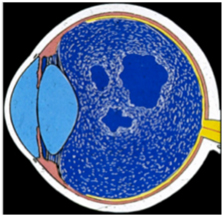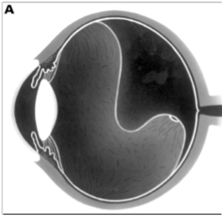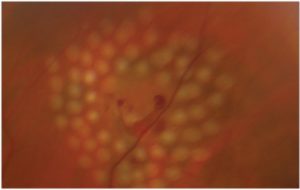As we age, the vitreous gel develops pockets of fluid within the centre and as a result, collapses inwards on itself, a process known as a posterior vitreous detachment (PVD). A PVD is a common occurrence, that occurs in everyone at some point in their life usually from the age of 40 years but could occur at an earlier age due to trauma or in myopic eyes.
Figure 1: Pockets of fluid forming within the vitreous body. This process occurs with age and is a precursor to a Posterior vitreous detachment (PVD)
Figure 2: A posterior vitreous detachment (PVD) in evolution
When a PVD occurs, floaters, which are small opalescent flecks that drift around in the field of vision become apparent. They may be more noticeable when looking at a plain background and some people may mistake floaters for flying insects. Arcs of flashing light particularly noticeable in dim lighting conditions may also become visible. These small flashes are light are a result of the retina being pulled upon as the vitreous detaches from the retinal surface.
When the vitreous detaches from the retinal surface during a PVD, a retinal tear may be caused. Untreated, this tear in the retina has a significant chance of resulting in a retinal detachment which will then require surgery. As such, anyone with new symptoms of floaters and flashes, needs to have a retinal examination performed to rule out the presence of a tear in the retina. If a tear in the retina is found, this will need to be treated with spots of laser applied in a circular fashion around the tear, or cryotherapy (freezing) to the tear itself.
Figure 3: Laser burns surrounding a retinal tear



